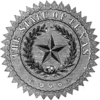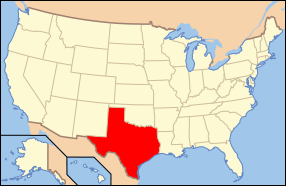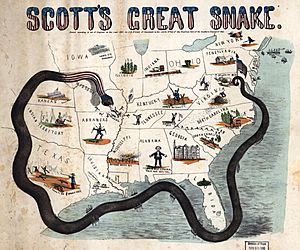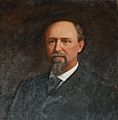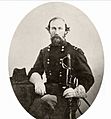Texas in the American Civil War facts for kids
Quick facts for kids Texas |
|||||
|---|---|---|---|---|---|
| Nickname(s): "The Lone Star State" | |||||
|
|||||
| Capital | Austin | ||||
| Largest City | Houston | ||||
| Admission to confederacy | March 23, 1861 (4th) | ||||
| Population |
|
||||
| Forces supplied |
|
||||
| Major garrisons/armories | Galveston Harbor | ||||
| Governor | Sam Houston Edward Clark Francis Lubbock Pendleton Murrah |
||||
| Lieutenant Governor | John McClannahan Crockett Fletcher Stockdale |
||||
| Senators | William Simpson Oldham, Sr. Louis Trezevant Wigfall |
||||
| Representatives | List | ||||
| Restored to the Union | March 30, 1870 | ||||
Texas decided to leave the United States on February 1, 1861. It then joined the Confederate States on March 2, 1861. This happened after its governor, Sam Houston, refused to promise loyalty to the Confederacy and was removed from his job. The U.S. government in Washington, DC did not agree with Texas's decision to leave.
Some Texas soldiers fought in the Civil War east of the Mississippi River. But Texas was mostly important for providing soldiers and horses for the Confederate Army. This role lasted until mid-1863, when Union ships gained control of the Mississippi River. This made it hard to move large numbers of men, horses, or cattle. Some cotton was sold in Mexico, but most of the cotton crop became useless. This was because the Union Navy blocked ports like Galveston and Houston.
Contents
Why Texas Left the Union
In late 1860, Texas counties sent people to a special meeting to discuss leaving the United States. This meeting approved a document called the "Ordinance of Secession" by a vote of 166 to 8. People then voted on this decision on February 23, and it was approved.
Texas also released a statement explaining why it was leaving. This document gave several reasons for secession. It mentioned supporting other states that allowed slavery. It also blamed the U.S. government for not stopping Native American attacks and other border problems. The document accused politicians and abolitionists from the North of causing trouble for Texans.
A big part of the document tried to explain why slavery was important. It said that staying in the United States would put the safety of slavery at risk. The declaration included a quote that praised slavery. It said that governments were made only by white people for themselves and their families. It also claimed that African people had no part in creating these governments. The quote stated that African people were seen as a "lower and dependent race." It said that only in this condition could their lives in the country be good or acceptable.
At this time, about 30% of Texas's population was African American. Most of them were enslaved. One Texan said that keeping people enslaved was the main reason the state joined the Confederacy. He wrote that "Independence without slavery, would be valueless." He also said, "The South without slavery would not be worth a mess of pottage."
The Secession Meeting and the Confederacy
After Abraham Lincoln was elected president in 1860, many people in the southern states that grew cotton wanted to leave the Union. By February 1861, six other states had already voted to secede. However, things were slower in Texas. This was mainly because Governor Sam Houston, who supported the Union, resisted. Unlike other southern governors, Houston did not want to call the Texas Legislature to discuss secession. He only agreed when it became clear that people were ready to act without him.
In December 1860, before South Carolina even left the Union, some state officials announced an election for delegates to a special meeting. This election happened on January 8, 1861. The election was unusual. Often, people voted by voice at public meetings. People who supported the Union were often discouraged from attending or chose not to participate. This led to many delegates who supported secession being chosen.
The election announcement said the delegates would meet on January 28. Governor Houston called the Legislature into session. He hoped they would declare the special meeting illegal. Houston expressed concerns about Lincoln's election. But he urged Texas to reject secession. He warned about the terrible effects of war and that the South would likely lose. The special meeting removed Houston from his position as governor. They then promoted the Lieutenant Governor, Edward Clark. The Texas Legislature did vote to pay for the delegates' expenses. They also promised to support the meeting's actions, even though Houston disagreed. The only condition was that the people of Texas would have the final say in a vote.
With the governor's efforts defeated, the Secession Convention met on January 28. Their first action was to vote to support the Legislature's decision. They agreed that if a secession order was passed, it would be put to a statewide vote. The next day, the meeting's president, Oran Milo Roberts, suggested that Texas leave the Union.
The order to secede was read the following day. It listed the federal government's failures to protect the lives and property of Texans. It also accused Northern states of using these issues to harm the Southern people.
After listing these complaints, the order canceled the agreement from July 4, 1845. This was when Texas joined the United States and accepted the Constitution of the United States. It also removed all powers, duties, and loyalty to the U.S. federal government and its Constitution.
To make it historically important, the order was set to take effect on March 2. This was the date of the Texas Declaration of Independence. It was also, by chance, Sam Houston's birthday.
On February 1, members of the Legislature and a large crowd watched the final vote on secession. Seventy "yes" votes were recorded before a single "no." One of the "no" votes is famous in Texas history books. James W. Throckmorton, from Collin County, voted against secession. When people hissed and booed, he replied, "When the rabble hiss, well may patriots tremble." The crowd, impressed by his courage, gave him some applause. Like many Texans who first opposed secession, Throckmorton accepted the result. He served his state and became a brigadier-general in the Confederate army.
The final vote for secession was 166 to 7. This was the highest percentage of "yes" votes in any state in the Deep South, except for South Carolina, where the vote was unanimous. On February 7, the Legislature ordered a public vote on the secession order. The decision was confirmed on February 23. Texas voters approved the measure with 46,129 votes for and 14,697 against.
The last task was to choose people to represent Texas in Montgomery, Alabama. There, representatives from the other six seceding states were meeting to form a new Confederacy. On March 4, the Texas meeting gathered again. They officially declared Texas out of the Union. They also approved the "Constitution of the Confederate States of America." Texas had actually already been accepted into the Confederacy on March 1.
In March, George Williamson, a commissioner from Louisiana, spoke to the Texas secession meeting. He urged Texas and other slave states to leave the Union to continue slavery. He said, "Louisiana looks to the formation of a Southern confederacy to preserve the blessings of African slavery." He believed that with slavery, their Southern government would last forever.
Governor Sam Houston accepted that Texas had seceded. But he argued that the meeting had no right to link the state with the new Southern Confederacy. Instead, he wanted Texas to become an independent republic again and stay neutral. Houston was supposed to take an oath of loyalty to the Confederacy on March 16. He remained silent when his name was called three times. Because he did not respond, the governor's office was declared empty, and Houston was removed.
Taking Over Federal Property
After Texas passed its secession order, the state government chose four "Commissioners of Public Safety." Their job was to talk with the federal government about safely transferring military bases in Texas to the Confederates. These commissioners met with U.S. Army General David E. Twiggs on February 8, 1861. They arranged for the surrender of federal property in San Antonio. This included military supplies stored in the old Alamo mission.
As a result of these talks, General Twiggs handed over his entire command and its Army property, including 10,000 rifles, to the Confederacy. This action caused many Union supporters in the state to call it treason. Soon after, President Buchanan removed Twiggs from the U.S. Army for "treachery to the flag of his country." Twiggs then became a general in the Confederate Army. He was so angry about being called a traitor that he wrote a letter to Buchanan. He said he intended to meet him for a "personal interview," which was a way of saying he wanted to fight a duel.
Future Confederate general Robert E. Lee was a colonel in the U.S. Army in San Antonio at the time. When he heard about the surrender to Texas, he asked, "Has it come so soon as this?"
Texans Who Opposed Secession
Even though most politicians and delegates wanted to secede, many Texans were against it. The vote on secession showed that about 25% of the white men who could vote wanted to stay in the Union.
Most of the people against secession were German Texans in the Texas Hill Country. Also, some counties in North Texas had many people who opposed it. Most residents there were originally from states in the Upper South. Some leaders who first opposed secession later accepted the Confederate cause. Others left public life, or even joined the Union army. Confederate laws forced most men of military age into the Confederate army, no matter how they felt. However, at least 2,000 Texans joined the Union forces.
Many Union supporters were killed. Being forced into the Confederate Army was not acceptable to many Unionists. Some tried to escape from Texas. In August 1862, Confederate soldiers found a group of German Texans trying to leave the state. They attacked their camp by the Nueces River. About 19 Unionists were killed in the fighting. After the battle, 9 to 11 wounded Unionists were murdered in what became known as the Nueces massacre. Another nine Unionists were hunted down and killed in the following weeks. The German people around Austin County, led by Paul Machemehl, successfully reached Mexico.
In October 1862, about 150 settlers in Cooke County were arrested. They were accused of planning to take weapons and kill their Confederate neighbors. They were also accused of planning to help Union army forces. A court was held in Gainesville to try them. About forty Unionists were hanged in Gainesville. Two were shot trying to escape. Two more were hanged later. The evidence against them was questionable, and the legal process was not fair. A monument marks the spot where the hangings happened.
The Confederacy's draft law was controversial. It said that men who owned fifteen or more enslaved people did not have to join the army. Many people, especially Texans of German or Mexican background, resisted the draft. Many Mexican Texans went to Mexico. People hid to avoid being drafted. Confederate officials hunted them down, and many were shot or captured and forced into the army.
Sam Houston's Stance
Sam Houston was the most important Union supporter in Texas. He owned enslaved people and did not like Lincoln's election. But he believed leaving the Union was against the law. He thought it was a "rash action" that would surely lead to a war where the industrial and more populated North would win. He predicted that after losing many lives and much money, the South might win independence, but he doubted it. He said the North was determined to keep the Union together. He feared they would "overwhelm the South."
Houston disagreed with the actions of the Texas Secession Convention. He believed it had gone beyond its power by joining the new Confederacy. He refused to promise loyalty to the Confederacy and was removed from his job. In a speech he wrote but did not give, he said he refused the oath in the name of Texans' rights and liberties, the nationality of Texas, and the Texas Constitution. He also said he refused in the name of his own conscience. He denied the convention's power to speak for Texas and declared their actions "null and void."
After being removed from the governor's office, Houston stayed out of public view until he died in July 1863. Before he died, Houston wrote to a friend in June 1861. He said, "There comes a time a man's section is his country...I stand with mine." He added that he was a citizen of the United States, but now he was a citizen of the Southern Confederacy.
Military Service in Texas
Over 70,000 Texans served in the Confederate army. Texas soldiers fought in almost every major battle of the war. Some men were experienced from the Mexican–American War. A few had even fought in the earlier Texas Revolution. Texas provided the Confederacy with many cavalry, infantry, and artillery units. The state also paid for some extra troops for home defense. In 1862, the Confederate Congress passed a law that ordered all men aged 18 to 45 to join the military. Exceptions were made for ministers, government officers, and certain slave owners. Anyone owning 20 or more enslaved people was exempt from the draft.
When the first Texas soldiers arrived in Richmond, Virginia, Confederate President Jefferson Davis greeted them. He said that soldiers from other states had to earn their reputations. But the Texans, as "sons of the defenders of the Alamo," had theirs to keep. He was sure they would be loyal.
"The Texas Brigade" was a famous unit. It was made up of the 1st, 4th, and 5th Texas Infantry Regiments. They often served as "shock troops" for General Robert E. Lee's Army of Northern Virginia. General Lee often praised their fighting skills. He said that none had brought more honor to their home state than "my Texans." Hood's men suffered many losses in battles. This was especially true at the Battle of Antietam, and at Gettysburg.
"Walker's Greyhound Division" was a military division made up only of Texas units. It was the only division in the Confederate States Army to keep its single-state makeup throughout the war. Formed in 1862, it fought in the Western Theater. It was considered a strong part of the army.
Some of the most famous mounted units were Terry's Texas Rangers. These were former rangers and frontiersmen. Many later became law enforcement officers in the Old West. Another famous unit was the 33rd Texas Cavalry Regiment led by Colonel Santos Benavides. They protected the Confederate cotton trade routes from Texas into northern Mexico.
Over 2,000 Texas men joined the Union Army. One notable person was future Texas governor Edmund J. Davis. He first commanded the Union Army's 1st Texas Cavalry Regiment and became a brigadier general.
Texas's large German population around Austin County tried to stay neutral in the war. But they eventually left Confederate Texas for Mexico. East Texas gave the most support to secession. The only East Texas counties where many people opposed secession were Angelina County, Fannin County, and Lamar County. However, these counties still sent many men to Texas regiments.
In 1862, Abraham Lincoln named Andrew J. Hamilton, a former U.S. Congressman, as the Military Governor of Texas. Hamilton held this title throughout the war. During the early part of Reconstruction, Hamilton was named the first temporary civilian governor. After that, active U.S. Army officers served as military governors of Texas for a time.
Years into the war, one Confederate soldier from Texas explained why he fought for the Confederacy. He said, "we are fighting for our property." He believed Union soldiers were fighting for the "flimsy and abstract idea that a negro is equal to an Anglo."
Battles in Texas
Texas did not have many large battles. However, the Union tried several times to capture the "Trans-Mississippi" areas of Texas and Louisiana from 1862 until the war ended. With ports to the east captured or blocked, Texas became a place where people could secretly bring goods in and out.
Union Efforts to Control Texas
Under the Anaconda Plan, the Union Navy blocked the main seaport, Galveston, and all Gulf and Southern borders for four years. Federal troops occupied Galveston for three months in late 1862. Confederate troops led by Gen. John B. Magruder took the city back on January 1, 1863. It stayed in Confederate hands until the end of the war. A few days later, the Confederate ship CSS Alabama attacked and sank the USS Hatteras off the coast of Galveston.
Civilian Blockade Runners mostly avoided the Union blockades and bandits. They also avoided Mexicans who supported the Union. They smuggled cotton out of The Port of Bagdad, Mexico. They sold it for a high price in exchange for goods from Europe and on black markets. Texas offered a great chance to export Southern cotton out of the Confederacy. President Lincoln spoke about the importance of this trade through the Rio Grande to the Secretary of War, Edwin Stanton in 1863. He said, "no local object is now more desirable." The Rio Grande Expedition, led by General Nathaniel P. Banks, was then sent to secure the ports near Brownsville. They pushed 100 miles inland to stop the flow of cotton and limit movement.
A few other cities also fell to Union troops at times during the war. These included Port Lavaca, Indianola, and Brownsville. Union attempts to take control of Laredo, Corpus Christi, and Sabine Pass failed. By the end of the war, only Brazos Island and El Paso were in Union hands. The California Column occupied the area around El Paso from 1862 until the war ended.
The most important military battle in Texas during the war happened on September 8, 1863. At the Second Battle of Sabine Pass, a small group of 46 Confederates, mostly Irish Davis Guards, defeated a much larger Union force. This Union force was from New Orleans and led by Gen. William B. Franklin. The accurate shooting by the Davis Guards disabled the lead ships in Franklin's fleet. This caused the rest of his force—4,000 men on 27 ships—to retreat back to New Orleans. This victory against such great odds led the Confederate Congress to give a special award, the Davis Guards Medal. This was the only military award given by the South at that time. Confederate President Jefferson Davis said, "Sabine Pass will stand, perhaps for all time, as the greatest military victory in the history of the world."
In 1864, many Texas forces, including a division led by Camille de Polignac, a French prince and Confederate general, moved into Northwestern Louisiana. Their goal was to stop Union Maj. Gen. Nathaniel Banks' Red River Campaign. This campaign aimed to move into Texas from its eastern border. Confederate forces stopped the Union expedition at the Battle of Mansfield, just east of the Texas border.
Union forces from Brazos Island launched the Brazos Santiago Expedition. This led to the last battle of the Civil War, the Battle of Palmito Ranch. It was fought in Texas on May 12, 1865, well after Robert E. Lee surrendered on April 9, 1865, in Old Appomattox Court House, Virginia.
Confederate Authority Collapses in Texas
In the spring of 1865, Texas had over 60,000 soldiers in the Army of the Trans-Mississippi. These soldiers were far from the main fighting areas. Their spirits had dropped, and many were leaving the army or stealing. News of Lee's surrender and other Confederate generals east of the Mississippi reached Texas around April 20. Local Confederate leaders had different ideas about what to do next. Most senior military leaders, including General Kirby Smith, vowed to continue the war. However, many soldiers made fun of speeches telling them to "fight on, boys," or simply didn't show up.
May brought more and more soldiers leaving the army. News of Joseph E. Johnston's and Richard Taylor's surrenders confirmed that Texas, Louisiana, and Arkansas were basically alone in continuing the Confederate cause. On May 14, troops in Galveston briefly rebelled. But they were convinced to stay armed. However, morale continued to sink. Generals John B. Magruder and Kirby Smith no longer tried to rally their soldiers. Instead, they began discussing how to divide Confederate government property. Magruder argued that quickly breaking up the army would prevent angry soldiers from harming civilians.
The rush to disband the army, along with the need to protect Confederate property from the Union, caused chaos. Soldiers began openly looting stores in Galveston on May 21. Over the next few days, a crowd demanded that a government warehouse be opened to them. Soldiers stopped and robbed a train. Several hundred civilians looted the Lark ship when it docked on May 24. Troops sent to calm the crowd soon joined in the looting. On May 23, people in Houston looted the weapons building and clothing office. Riots continued in the city until May 26. Both government and private stores were heavily raided in many towns. In Navasota, a powder explosion killed eight people and destroyed twenty buildings. In Austin, the State Treasury was raided, and $17,000 in gold was stolen. By May 27, half of the Confederate forces in Texas had left or been disbanded. Order had disappeared in many areas of Texas, replaced by lawlessness.
The remaining parts of Kirby Smith's army finally fell apart by the end of May. When he arrived in Houston, the general called an investigation. It was to find out why the troops in Texas, New Mexico, and Arizona had disbanded. The findings on May 30 blamed the civilian population. Kirby Smith spoke to his few remaining soldiers. He criticized those who had fled for not fighting until the end. He said they left him "a commander without an army– a General without troops." On June 2, he officially surrendered what was left of the Army of the "Trans-Mississippi."
Texas Returns to the Union
After the Civil War ended, Texas was part of the Fifth Military District.
Federal troops did not arrive in Texas to restore order until June 19, 1865. On that day, Union Maj. Gen. Gordon Granger and 2,000 Union soldiers arrived on Galveston Island. They came to take control of the state and make sure former slaves were free. The Texas holiday Juneteenth celebrates this date. The U.S. flag was not raised over Austin until June 25.
President Andrew Johnson appointed Union General Andrew J. Hamilton as the temporary governor on June 17. Hamilton was a well-known politician before the war. He offered forgiveness to former Confederates if they promised to support the Union in the future. He even appointed some of them to government jobs. On March 30, 1870, the United States Congress allowed Texas's representatives to take their seats in Congress. This happened even though Texas had not met all the official requirements to rejoin the Union.
Important Leaders from Texas During the Civil War
Many important leaders were connected to Texas during the Civil War. John Bell Hood became famous as the commander of the Texas Brigade in the Army of Northern Virginia. He played a big role as an army commander later in the war. "Sul" Ross was an important leader in several Confederate armies in the "Trans-Mississippi" area. Felix Huston Robertson was the only Confederate general born in Texas. Capt. T. J. Goree was a trusted helper to Lt. General James Longstreet. John H. Reagan was an important member of Jefferson Davis's cabinet. Col. Santos Benavides was a Confederate colonel. Benavides was the highest-ranking Tejano (Texan of Mexican heritage) soldier in the Confederate military.
The job of Governor of Texas changed often during the war. Several men held power at different times. Sam Houston was governor when Texas left the United States. But he refused to promise loyalty to the new Confederacy. He was replaced by Lieutenant Governor Edward Clark. Clark finished Houston's term in 1861. He then lost re-election by only 124 votes to Francis Lubbock. During his time as governor, Lubbock supported the Confederate draft. He worked to force all able-bodied men, including foreign residents, into the Confederate army. When Lubbock's term ended in 1863, he joined the military. Strong supporter of secession, Pendleton Murrah, replaced him. Even after Robert E. Lee surrendered in 1865, Murrah encouraged Texans to keep fighting. He and several supporters fled to Mexico.
Notable Civil War Leaders (Confederacy) from Texas
-
Governor
Francis Lubbock -
Postmaster General
John Henninger Reagan -
Gen.
A. S. Johnston -
Lt. Gen.
John Bell Hood -
Brig. Gen.
Felix Huston Robertson -
Brig. Gen.
Benjamin McCulloch -
Lt. Col.
Santos Benavides
Notable Civil War Leaders (Union) from Texas
-
Governor
Sam Houston (Union) -
Governor
Andrew J. Hamilton -
Brig. Gen.
Edmund J. Davis
After the War
Texas was one of the first states to join the Confederate States of America. However, much of Texas was not settled until after the Civil War. Today, Confederate Heroes Day is an official state holiday in Texas. The Texas Senate also recognizes April as Confederate History Month. Although not an official holiday, April 26 is often observed as "Confederate Memorial Day" by Southern historical groups in the state.
On the south lawn of the state capital in Austin, there is a Confederate monument. Several other memorials to individual Texas Confederate military units are nearby. Also, most Texas county courthouses have a Confederate memorial.
Houston, Texas's largest city, had a monument to the Confederacy in its oldest city park, Sam Houston Park. It was called Spirit of the Confederacy. It was made of bronze in 1908. However, Houston mayor Sylvester Turner announced on June 11, 2020, that it would be removed. It was moved to the Houston Museum of African American Culture on June 17, 2020.
See also
- Confederate States of America – animated map of state secession and Confederacy
- List of Texas Civil War Confederate units
- List of Texas Civil War Union units
- History of slavery in Texas



